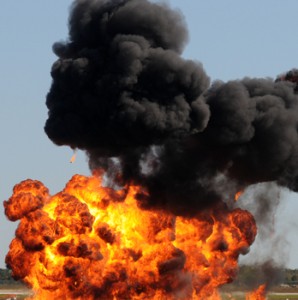Two separate accidents across the Williston region on Saturday have added to the growing concern about Bakken oil safety and is fueling the intense debate about the way oil is produced, contained and transported in the United States.
In a new series of posts, we will examine this issue and try to separate the facts from the hype and the science from the scare tactics.
Related: Bakken Oil Transport Still Not Safe
Explosions Galore
An explosion erupted at 3:00am at an oil and gas waste disposal site north of Alexander, N.D. in McKenzie County. There were no injuries reported, but the massive fire spread to eight storage tanks and was so intense that emergency crews decided to let it burn itself out. The flames subsided by mid morning just as three oil tanks operated by Marathon went up in flames another 53 miles away, near the small town of Killdeer. These incidents were only a few weeks after eight tanks were destroyed in the same area as 1500 barrels of crude blazed across the street from an Enbridge facility.
Crude by Rail
A top concern when thinking about Bakken oil safety is the transport of crude by rail.
“According to one report, “there were 117 crude-by-rail spills in the United States during 2013, a near-tenfold rise since 2008 (...) and there were more such spills in 2014 than in any year since the federal government began collecting data on spill incidents in 1975.”
With oil production currently at all time highs, the amount of crude traveling the country will escalate and, many fear, so may the number of accidents.
Just in the last few weeks, there have been a number of news reports of these accidents:
- 3/8/15:Train carrying crude oil derails in northern Ontario more
- 3//7/15 Train carrying crude oil derails in Canada more
- 3/6/15: Oil train carrying Bakken crude explodes in Illinois more
- 2/14/15 Train carrying crude oil derails in Canada more
- 2/17/15: WV derailment carries Bakken crude in more
Next in the series: Is Bakken crude really more dangerous?

